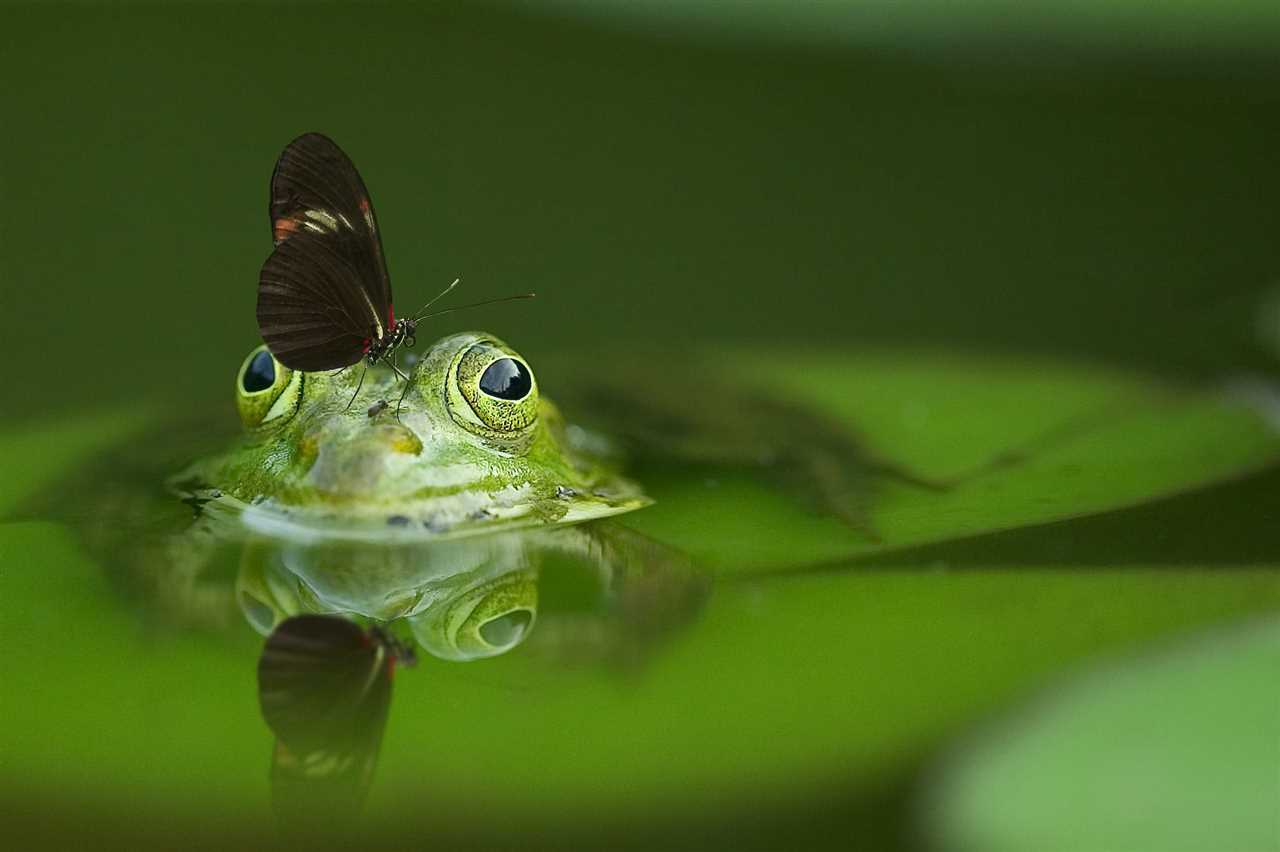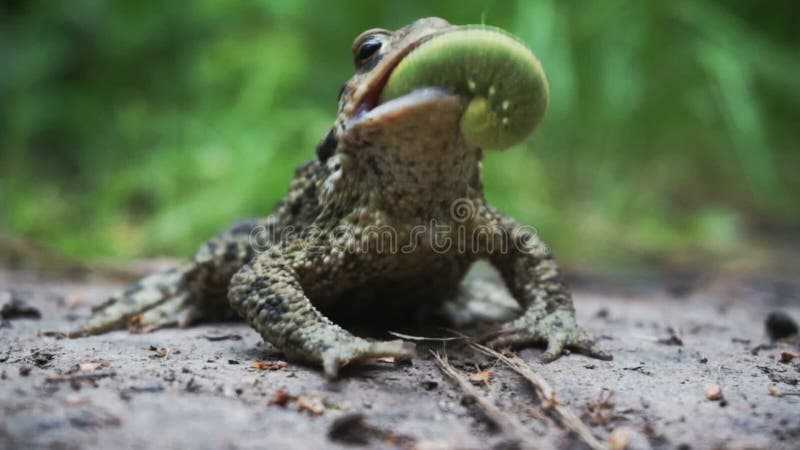
While it is true that many species of frogs do consume caterpillars as part of their diet, not all frogs exhibit this behavior. Frogs are opportunistic feeders and have a wide range of food preferences depending on their habitat and availability. Some frogs feed primarily on insects, while others consume small vertebrates or even plants.
It is also worth noting that the consumption of caterpillars by frogs can have an important ecological impact. Caterpillars are herbivorous insects that can cause significant damage to plants and crops. By eating caterpillars, frogs can help to naturally control their populations and reduce the potential for agricultural damage.
Frogs: An Overview
Frogs are a diverse and widespread group of amphibians known for their unique life cycle and ability to inhabit a variety of habitats. There are over 6,000 known species of frogs, ranging in size from as small as a dime to as large as a dinner plate. They can be found on every continent except Antarctica.
Life Cycle
Habitats and Adaptations
Frogs are incredibly adaptable and can be found in a wide range of habitats, from rainforests to deserts. They have a moist, permeable skin that allows them to breathe through it, which is why they are often associated with wet environments. However, some species of frogs have adapted to live in drier habitats by developing methods to prevent water loss, such as burrowing underground or creating a mucus layer on their skin.
Frogs are also well-known for their ability to jump. Their hind legs are highly muscular, allowing them to leap long distances in search of food or to escape predators. They have evolved to have webbed feet, which helps them swim efficiently in water. Additionally, frogs have a unique tongue that can shoot out quickly to catch prey, such as insects or worms.
Ecological Importance
Caterpillars: An Overview
During their larval stage, caterpillars primarily feed on plant material, mainly leaves. They have powerful mandibles that allow them to chew and consume plant matter efficiently. Caterpillars have developed different feeding strategies depending on their species and the plants they eat. Some species are generalists and will eat a wide range of plant species, while others are more specialized and will only feed on specific plants.
The Importance of Caterpillars in Ecosystems
Caterpillars are crucial for the health and balance of ecosystems because of their role as herbivores. By consuming leaves, they help maintain the growth and regeneration of plant populations. Furthermore, their feeding activities can shape plant communities by influencing which species thrive in a particular area. Caterpillars also contribute to nutrient cycling by breaking down plant matter and releasing nutrients back into the soil.
Interactions Between Frogs and Caterpillars
Frogs are carnivorous creatures, meaning they primarily feed on other animals. Caterpillars, on the other hand, are the larval stage of butterflies and moths, and they primarily feed on plant material. So, it might seem unlikely for frogs to include caterpillars in their diet.
One possible explanation for this behavior is that caterpillars are a source of high-quality protein for frogs. While frogs can survive on a diet of insects alone, including caterpillars in their diet may provide additional nutritional benefits.
It is also worth noting that not all species of frogs include caterpillars in their diet. The presence of caterpillars in a frog’s diet may vary depending on factors such as habitat, availability of other prey items, and the frog’s own feeding preferences.
Overall, the interactions between frogs and caterpillars highlight the complex nature of predator-prey relationships in the animal kingdom. While frogs are primarily insectivorous, their diet can include caterpillars, demonstrating their adaptability as opportunistic feeders.
Frog Diet: What Do Frogs Normally Eat?
Frogs have a diverse diet that primarily includes insects, spiders, small fish, and even small birds or mammals. However, the specific diet of a frog can vary depending on its species, size, and habitat.
Insects
The most common food source for frogs is insects. They have a remarkable ability to catch flies, mosquitoes, beetles, crickets, and other small flying or crawling insects. Frogs have a long, sticky tongue that they can quickly extend to catch their prey.
Spiders
Frogs also prey on spiders, especially those that are found in or near wetlands. They can quickly lunge at a spider and grab it with their mouth.
Small Fish
Small Birds or Mammals
In rare cases, larger frogs have been observed eating small birds or mammals. This usually happens when the opportunity presents itself, such as when a young bird or mammal falls into the water where the frog is present.
Do caterpillars eat?
Yes, caterpillars do eat.
Caterpillars are the larvae of butterflies and moths, and they have a voracious appetite. They feed exclusively on plant material, primarily leaves. Caterpillars have a specialized mouthpart called a mandible, which they use to chew and consume plant matter.
While some caterpillars are generalists and will consume a wide range of plants, others are more specialized and will only eat specific types of plants. Caterpillars have evolved to adapt to the chemicals and defenses of the plants they feed on, allowing them to utilize a variety of different resources.
As caterpillars grow, they molt several times, shedding their old skin and growing a new one. During this process, they consume even more food to support their rapid growth. Once they have consumed enough food and reached a certain size, they will pupate and eventually emerge as adult butterflies or moths.
In summary, caterpillars are active feeders that eat plant material in large quantities. They are essential components of ecosystems and serve as a valuable food source for other organisms.
Research: Do Frogs Include Caterpillars in Their Diet?

One commonly debated topic among researchers and biologists is whether or not frogs include caterpillars in their diet. While the diet of frogs primarily consists of insects, such as flies, mosquitoes, and beetles, there is evidence to suggest that some species of frogs do consume caterpillars.
Several studies have been conducted to investigate the dietary preferences of frogs and their potential consumption of caterpillars. These studies have involved observing the feeding behavior of frogs in their natural habitats and analyzing the contents of their stomachs through dissection.
One study conducted in a tropical rainforest found that a certain species of tree frog showed a particular interest in caterpillars. The researchers observed the frogs actively hunting and consuming caterpillars that were present in their environment. This suggests that for this specific species of frog, caterpillars may form a significant part of their diet.
Furthermore, another study focused on a different species of frog found in a grassland ecosystem. This species was found to occasionally consume caterpillars, although not as frequently as other insects. It is possible that the availability of caterpillars in their environment and their own foraging behaviors influence their decision to include them in their diet.

I’m Lena Adams—a product of an unconventional upbringing in the African wilderness. My father, a daring explorer of African wildlife, sparked my fascination with reptiles, a passion that intertwined with the tragic loss of my mother during an expedition, leaving an indelible mark on my life. Driven to understand the creatures that captivated my parents, I embarked on my journey, sharing insights about reptiles, frogs, and lizards on my website. Through my explorations and conservation efforts, I honour my family’s legacy while seeking connections—to the creatures, nature, and the mother whose presence I yearn to understand.
